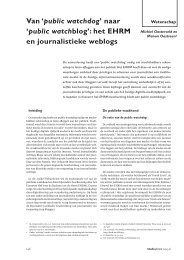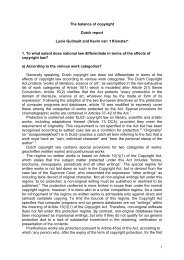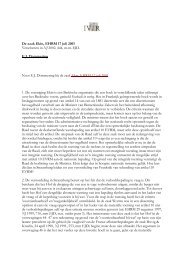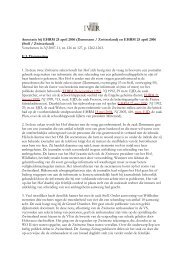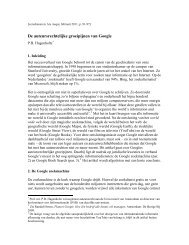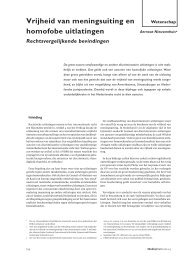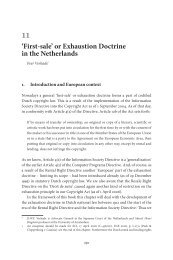ADAPTING COPYRIGHT TO THE INFORMATION ... - IViR
ADAPTING COPYRIGHT TO THE INFORMATION ... - IViR
ADAPTING COPYRIGHT TO THE INFORMATION ... - IViR
Create successful ePaper yourself
Turn your PDF publications into a flip-book with our unique Google optimized e-Paper software.
well researched. Moreover, `multimedia' works have been in existence, albeit in a<br />
somewhat primitive form, for many years; video games and moving pictures are wellknown<br />
examples of `multimedia' works avant la lettre.<br />
So, one might conclude, we have seen it all before: the arrival of the information<br />
superhighway is an evolutionary, not a revolutionary development. The existing<br />
copyright system has proven to be flexible enough in the past. There is no need for<br />
radical changes in the future; never change a winning team.<br />
Arguably, this down-to-earth approach would make a sensible and pragmatic short-term<br />
solution. If the European Software Directive 3 has proven anything, it is that legislators<br />
should not overreact to the problems presented by new information technologies. In the<br />
long run, however, this conservative approach will probably not suffice. The<br />
development of the information superhighway is, admittedly, a gradual process. But the<br />
combined effects of mass digitalization, networking on a global scale, and information<br />
delivery on demand, will eventually require more than just piece-meal changes to the<br />
present copyright system. The emerging digital networked environment is affecting the<br />
very economic underpinnings of the present copyright system. In the end, a thorough<br />
rethinking of the copyright paradigm will be probably be inevitable. 4<br />
No such exercise will be undertaken in this paper. Its main purpose is to suggest short<br />
term solutions, primarily from a European perspective, to some of the most pressing<br />
copyright problems of the digital networked environment. The focus of this paper, then,<br />
will be on the scope and limitations of the existing catalogue of protected rights (§§ 2-4).<br />
How do the various acts of network communication (digitization, uploading,<br />
transmission, browsing, viewing, downloading) fit in into the current system? Is there an<br />
imminent need for redefinition or clarification of the exploitation rights? Will existing<br />
copyright exemptions survive in the new environment? Does the good-old `old media'<br />
exhaustion rule come into play?<br />
Prior to these discussions, I will make some general observations on the nature of the<br />
`information superhighway', as it affects - or may affect - the law of copyright, both in<br />
theory and practice.<br />
1.1 The information superhighway<br />
In this paper, the `(information) superhighway' shall be short-hand for the digital<br />
networked environment of the near future. The superhighway is neither a new product,<br />
nor a new service, nor a new type of network. It represents the integrated, broad-band,<br />
high-speed, general-purpose telecommunications network of the coming century. The<br />
superhighway will not be a single physical network, but a conglomerate of local,<br />
regional, national and transnational telecommunications infrastructures, interlinked to<br />
form a global information superhighway.<br />
From a technical perspective, the superhighway is not homogenous. The necessary<br />
physical links will be provided by copper wires, optical fibres, radio links and satellites,<br />
3 Directive of the Council of the European Communities of 17 May 1991, O.J.EC L 122/42.<br />
4 See Egbert J. Dommering, `Copyright being washed away through the electronic sieve', elsewhere in<br />
this volume.



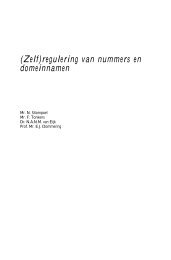
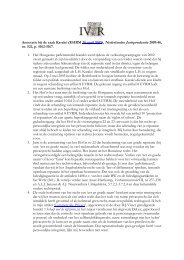

![Legal Opinion of Professor Egbert Dommering [1] concerning ... - IViR](https://img.yumpu.com/23603085/1/184x260/legal-opinion-of-professor-egbert-dommering-1-concerning-ivir.jpg?quality=85)
